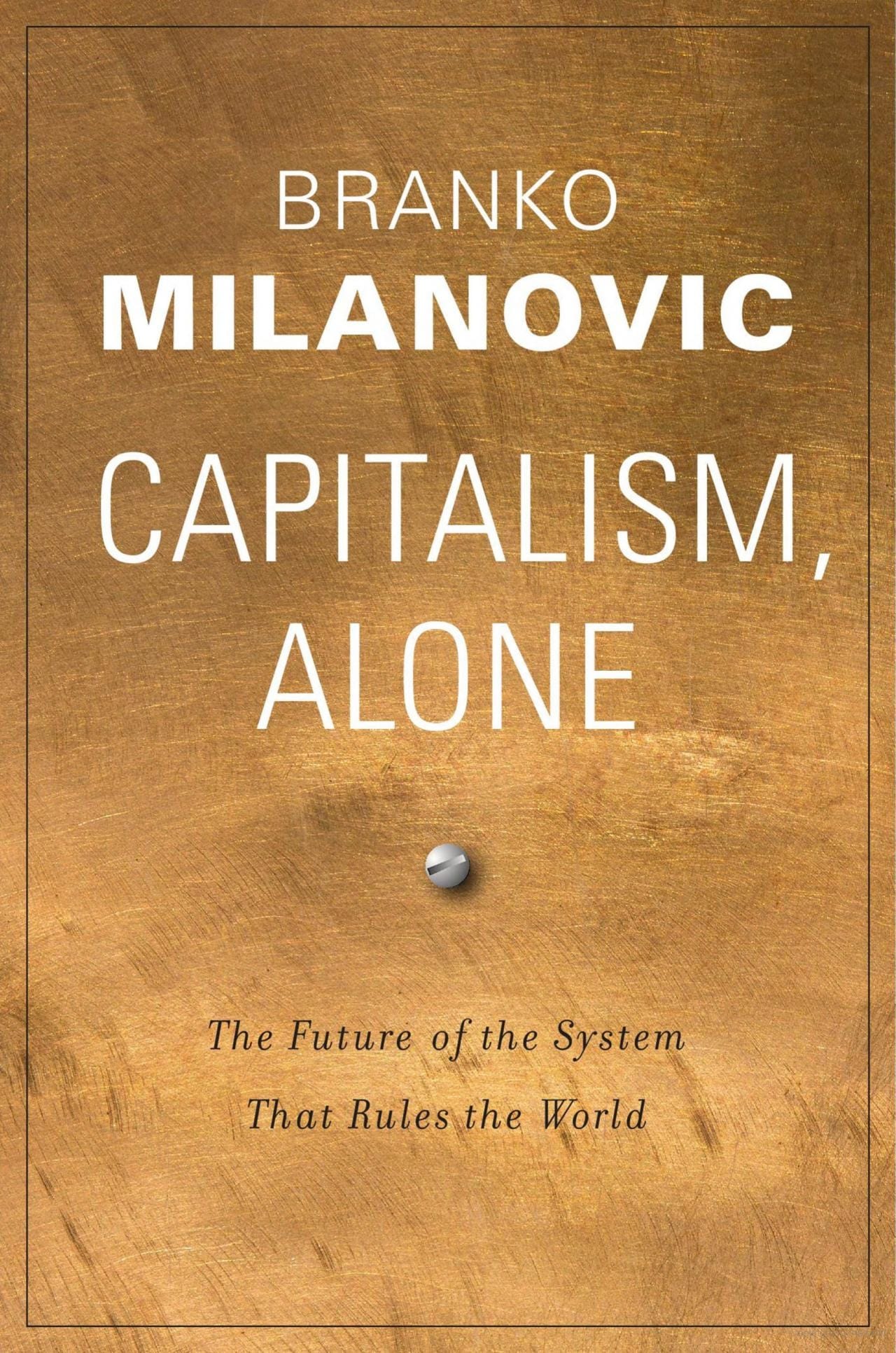recent
What Comes After Capitalism?
Milanovic suggests that these two developmental histories—gradual and revolutionary—give rise to the two distinctive models of capitalism in the world today: “Liberal meritocratic capitalism” in the West, and one-party “political capitalism” in countries like China, Vietnam, Malaysia and Ethiopia.

A review of Capitalism, Alone: The Future of the System That Rules the World, by Branko Milanovic, Belknap Press: An Imprint of Harvard University Press (September 24, 2019), 304 pages
“The domination of capitalism as the best, or rather the only, way to organize production and distribution seems absolute,” writes Branko Milanovic in his new book, Capitalism, Alone: The Future of the System That Rules the World. With feudal systems demolished, and the ideological battles between fascism and communism resolved, a clear winner has emerged.

Capitalism is unrivaled in its ability to produce material abundance and coordinate the use of scarce resources. But above and beyond that functional success, capitalist societies also inculcate a set of commercial values that reinforce its supremacy and reward its expansion into new spheres of life.
If capitalism contains the seeds of its own destruction, as Marx thought, such forces are overwhelmed by its propensity to spread and self-replicate—at least so far. As a leading scholar on income inequality at the City University of New York, Milanovic is sensitive to the “internal contradictions” of capitalism that remain. Capitalism, Alone represents his attempt to update Marx’s thought in light of capitalism’s durable success.
Consider the theory of historical materialism. Marx believed that economies transition through various necessary stages of development characterized by different modes of production. The primitive communism of hunter-gathers gives way to feudalism; feudalism is displaced by capitalism; capitalism creates the conditions of precarity for a socialist revolution, and so on. While Marxist-Leninists often debated what the “and so on,” would actually be, the culmination of history in a decentralized communist utopia was considered a scientific certainty.
This linear theory of history was falsified by the actual events of the twentieth century, Milanovic argues. If Marx’s theory were correct, for example, we would expect socialism to have been most successful in relatively developed, industrialized economies like East Germany and Czechoslovakia. Instead, industrialized economies are precisely those for which the “socialist calculation” problem of central planning is largest. The transition of the Soviet Union to capitalism after 1989 was thus an inconceivable historical regression according to orthodox Marxism.
But rather than throw out historical materialism altogether, Milanovic suggests Marx simply got the sequence wrong. Communism turned out to be the most successful in agricultural, Third World economies as a tool to vanquish feudalism, and thus lay the foundation for capitalism. This is validated by our best understanding of how countries like China and Vietnam initiated their economic development. After the Chinese Communist Party’s victory in 1949, for example, China abolished quasi-feudal systems in rural areas through comprehensive land reform, and weakened clan-based social relations by imposing nuclear family structures and gender equality. “This was no less than a complete overturning of historical hierarchical relationships,” notes Milanovic.
The famines spurred by China’s Great Leap Forward were catastrophic. Nonetheless, the broader political centralization and reorganization of society made “a tabula rasa of all ideologies and customs that were seen as retarding economic development and creating artificial divisions among people.” Western societies skipped this revolutionary step because they developed first, having overcome the feudal and familial barriers to growth in a much more gradual fashion. In this respect, the influence of Christianity is perhaps the most neglected factor in Milanovic’s account.
The spread of the Western Church throughout Europe centuries before the Industrial Revolution helped dissolve extended kin-group networks through prohibitions on cousin marriage. This ultimately created the social conditions for the emergence of democracy. Evidence for Christianity’s role includes empirical work by the economist Jonathan F. Schulz, which finds a strong correlation between exposure to the medieval Church and the formation of inclusive city- level institutions and urban population growth. Extending his thesis globally, Schulz even finds that the prevalence of cousin-marriages can “explain more than 50 percent of the variation in democracy across countries today.”
Milanovic suggests that these two developmental histories—gradual and revolutionary—give rise to the two distinctive models of capitalism in the world today: “Liberal meritocratic capitalism” in the West, and one-party “political capitalism” in countries like China, Vietnam, Malaysia and Ethiopia. Nonetheless, the egalitarian ethos spread by Christianity is important for understanding why the West became not just liberal, but democratic. Materialist accounts only get us so far.
In a democratic society, the equality of citizenship gives each member an ownership stake in the commonwealth. Western democracies still have hierarchical organizations like corporations, but the political system is relatively flat: civil servants and elected representatives work within the bounds of a social contract. China’s political system, in contrast, is itself like a top-down mega corporation. Its model of “regionally decentralized authoritarianism,” in which local and provincial leaders move up the ranks by hitting performance targets, even shares similarities with the governance structure of Japanese conglomerates. The ethos of China’s political capitalism is thus to treat citizens as contractual employees, rather than as equal owners with corresponding rights.

Indeed, political capitalist economies achieve spectacular growth rates by doing an end-run around the constraints of the rule of law and democratic negotiation. They prize efficient bureaucracies and the autonomy of the state, legitimized by continuously rising standards of living rather than the consent of “we the people.” The corruption endemic to political capitalism may even be a feature, Milanovic argues, helping to grease the wheel of rapid development.
Whether or not political capitalism can survive with the slower growth rates of a fully developed economy remains an open question. South Korea transitioned to a multiparty democracy peacefully. Singapore, on the other hand, has remained stable despite its First World status by reigning in corruption and formalizing its technocratic model of governance through carefully designed incentives.
Yet Milanovic argues that liberal meritocratic capitalism faces existential questions of its own. Rising inequality and open migration threaten the survival of the welfare states. Globalization has normalized tax evasion and other forms of transnational corruption. And technological change has increased the incomes of the highly educated, allowing them to live in tacit denial of their own privileged class positions. Inequality may be falling globally, yet the populist revolts of working class people across Western democracies suggest the final stage of liberal capitalism has yet to be reached.
Milanovic believes the West’s next evolution will be what he calls “people’s capitalism.” In this model, direct redistribution would be limited, but everyone would derive adequate income through approximately equal shares of labor and capital. Public education would be strengthened to reduce intergenerational inequality. High taxes on inheritances and campaign finance reforms would reduce the wealthy’s influence over politics. And binary notions of citizenship would be eliminated, allowing free migration without nationalist backlash. Milanovic suggests we can judge whether his vision is coming true by tracking trends in wealth inequality. This goal, combined with the “people” in people’s capitalism, gives the impression that such a future is not just likely but also desirable. In a sense, it would even represent a partial vindication for Marx—a higher form of capitalism that is internationalist in orientation, and which secures equality in the “pre-distribution” without forgoing the efficient “production and distribution” of the market.
But in another sense, people’s capitalism sounds like the apotheosis of a certain kind of vulgar neoliberalism: Cut the welfare state and birthright citizenship to allow free movement of labor, and give everyone personal investment accounts so working people can be capitalists, too. Whether or not people’s capitalism is a likely scenario is a separate question. If one adopts a materialist approach, history certainly seems to be moving in the opposite direction. Globalization has put pressure on open economies to reduce taxes on capital, for instance, in favor of immobile factors like land and consumption. High wealth taxes are thus unlikely to work absent capital controls or significant global coordination.

Open migration and the welfare state do not seem to be as incompatible as Milanovic thinks, either. The greatest conflicts between natives and immigrants arise in states where benefits are in-kind (like the relatively fixed supply of Danish and Austrian public housing), unconditional (like Norway’s generous child care benefit), clientelistic (like Greece’s reliance on public sector employment), or embedded within labor market institutions (like Germany’s trade unions). Such countries have responded by voucherizing benefits, decentralizing labor relations, and making social insurance more universal and contributory. This doesn’t represent the abolition of the welfare state, so much as a shift from corporatist and socialistic welfare states to the Anglo model. Milanovic’s tendency to lump quite different economic systems into reified “ideal types” causes him to gloss over these distinctions.
Milanovic’s focus on broad measures of inequality causes him to misdiagnosis liberal capitalism’s greatest threat, as well. Shifts in abstract wealth and income percentiles are a much smaller problem than the emergence of stark parallel societies—where migrants and an underclass are pushed to the periphery of civil society. Subdividing citizenship would only exacerbate this trend. Rentier states like Qatar may get by with exploitative guest worker programs, but liberal countries like Canada sustain high rates of immigration and social integration by emphasizing permanent residency and civic equality. By contrast, asylum seekers in Sweden are not automatically granted work permits, which contributes to the social exclusion of young Syrians and Iraqis and, if anything, heightens potentially hostile nativist sentiment.
The emergence of such parallel societies may be most stark in Europe, but restrictions on housing supply have helped produced a dual track economy across the entire Western world. Deindustrialization has hollowed out rural economies, while access to vibrant metro areas is increasingly limited by the high cost of housing. This causes cities from New York to Paris to self-select for an educated elite, who then get access to the best schools and professional connections. Providing disaffected workers with financial assets and better public education thus misses the extent to which social class is reproduced through segregated social networks. The lack of discussion on housing (except insofar as it represents an abstract source of financial returns) is a particularly strange omission given Milanovic’s discussion of land reform.
Put differently, the egalitarian ethos underlying Western liberal democracy is not just about the mere leveling of incomes; it refers to solidarity through social integration and a shared civic culture. Inequality ceases to be meritocratic when it reproduces itself, not by accident, by with the help of structures that promote segregation and exclusion. The accretion of such structures (regulations that restrict housing supply, two-tiered labor markets, and exclusive universities) is not necessarily an upper-class conspiracy. It occurs naturally enough through the institutional entropy and cultural complacency engendered by sluggish economic growth. There is thus no materialistic force that prevents liberal meritocratic capitalism from sliding back into a set of quasi-feudal relations—a “neo-medievalism” in which a metropolitan and scholastic aristocracy reclaims its nobility by locking-out the underclass. Whether these trends can be reversed crucially depends on the strength of our moral convictions, rooted in what the philosopher Jurgen Habermas once identified as “the Judaic ethic of justice and the Christian ethic of love.”
With Capitalism, Alone, Milanovic has written a data-rich, provocative account of where capitalism is today and where it may be headed. But while the book serves to correct many of Marx’s primitive errors, Milanovic nonetheless remains beholden to the same faulty paradigm. History cannot be fully understood through the lens of class conflict, modes of production, and highly aggregated concepts like labor and capital income. Materialist forces help explain the divergent paths of liberal and political capitalism, but culture and ideas matter, too. Most importantly, history has no predetermined path. Capitalist civilizations can always regress. And if we’re not vigilant, what’s old will become new again.






